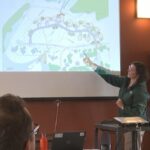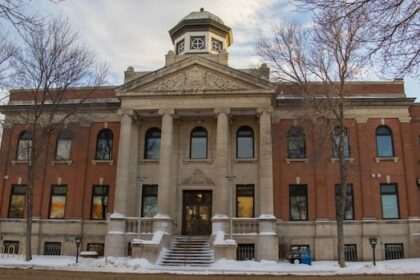SaskatchewanThe Peter Ballantyne Cree Nation is challenging the minister of environment’s approval of a uranium mine’s environmental assessment, stating the consultation was “inadequate.”Peter Ballantyne Cree Nation says consultation was ‘inadequate’Dayne Patterson · CBC News · Posted: Nov 02, 2025 6:00 AM EST | Last Updated: 11 hours agoListen to this articleEstimated 5 minutesPeter Ballantyne Cree Nation is opposing an environmental assessment cleared by Saskatchewan’s minister of environment, claiming it does not include proper consultation with the First Nation on a uranium mine in northern Saskatchewan. (Alexander Quon/CBC)Peter Ballantyne Cree Nation is challenging the environmental assessment of a proposed uranium mine in northern Saskatchewan, arguing the project will impede on their traditional territory without proper consultation.In an application for judicial review filed at the Court of King’s Bench last week, Peter Ballantyne Cree Nation is seeking an order to quash the environmental assessment of the proposed Wheeler River project. It wants to force the environment minister to reconsider, arguing the government’s consultation with the First Nation was “inadequate and not meaningful.”Denison Mines Corporation, a Toronto-based uranium mining, development and exploration company, is the majority stakeholder in the Wheeler River project and is also listed as a respondent to the application.The project is an in situ recovery uranium mining and processing operation located about 600 kilometres north of Saskatoon and would produce up to 5,400 tonnes of uranium oxide annually for a lifespan of 20 years, according to the federal government’s summary of the project status.Saskatchewan’s Minister of Environment, Travis Keisig, gave the proposed project a provincial stamp of approval in July, satisfied that it had met the requirements.Court documents say that while the Peter Ballantyne Cree Nation (PBCN) signed an adhesion to Treaty 6, its traditional territory is located in Treaty 10 territory, as is the project. PBCN is comprised of eight communities.“Most of our communities are in Treaty 10 territory, but they’re PBCN communities, and most of our traditional activities are in that area,” Chief Peter Beatty told CBC.“We have been hunting, trapping, fishing in these areas for hundreds of years and just because there’s a border line for Treaty 6 does not mean that our traditional rights don’t extend beyond that.”In an email Friday, the provincial Ministry of Justice said the government had not been served notice about the application but, given it is before the courts, said it would not provide comment.Saskatchewan government leaders are keen to position the province as a top uranium supplier. The Saskatchewan government also greenlit the largest uranium mine in Canada, the Rook I project, in November 2023. Like the Wheeler River project, Rook I is located in the Athabasca Basin, where most of Canada’s uranium reserves are held and home to the world’s largest high-grade uranium deposits. So far, Beatty said he is not certain if the project will pose environmental issues for its nearby communities because, he and the court application alleges, PBCN was not given ample time to review documents related to the project.”We feel that there is going to be, definitely, some impact on the environment and we’d like to know what those are and in order for us to do that, we’d have to do a proper assessment of it and have our own experts look at the data,” Beatty said.PBCN’s application alleges that by the time the Government of Saskatchewan looked to consult the First Nation, after failing to do so earlier, Denison Mines had already completed its final environmental impact statement.It also said the provincial government “only provided PBCN with six weeks” to comment on the environmental impact statement, and would not provide an extension when requested. “PBCN had neither sufficient time nor resources to meaningfully consult in that span of time,” the application says.Beatty said the government should have consulted the First Nation prior to the completion of the report.Documents detail a back-and-forth between the provincial government and PBCN about whether the community was owed a duty to consult, showing the province asked for more specific information about land and hunting rights, but PBCN could not respond to those information requests “without capacity funding.”The court documents allege that before Denison submitted an environmental assessment application in early 2019, it engaged with several Indigenous communities about the proposed project, but not PBCN. Nor was PBCN listed as a community potentially affected by the project.In a report from Denison Mines in November 2024, the company states its representatives met with PBCN representatives as early as May 2023, and communicated with them through January, but was not given information about how the project would adversely affect PBCN land uses and rights.The company report said the community had asked for capacity funding to assist with responding to information requests.The First Nation’s application says that report does not list “various issues” PBCN raised with Denison Mines about the project.CBC made several attempts to contact Denison Mines for comment, but did not receive a response before deadline.The second of two federal commission hearings for the project are scheduled for Dec. 8. The hearings were set to consider the environmental assessment for the project and the licence application from the Canadian Nuclear Safety Commission, which is required for the proposed project to proceed.ABOUT THE AUTHORDayne Patterson is a reporter for CBC News. He has a master’s degree in journalism with an interest in data reporting and Indigenous affairs. Reach him at dayne.patterson@cbc.ca.TwitterWith files from Aishwarya Dudha
Friday, 19 Dec 2025
Canada – The Illusion
Search
Have an existing account?
Sign In
© 2022 Foxiz News Network. Ruby Design Company. All Rights Reserved.
You May also Like
- More News:
- history
- Standing Bear Network
- John Gonzalez
- ᐊᔭᐦᑊ ayahp — It happened
- Creation
- Beneath the Water
- Olympic gold medal
- Jim Thorpe
- type O blood
- the bringer of life
- Raven
- Wás’agi
- NoiseCat
- 'Sugarcane'
- The rivers still sing
- ᑲᓂᐸᐏᐟ ᒪᐢᑿ
- ᐅᑳᐤ okâw — We remember
- ᐊᓂᓈᐯᐃᐧᐣ aninâpêwin — Truth
- This is what it means to be human.
- Nokoma











